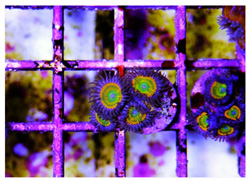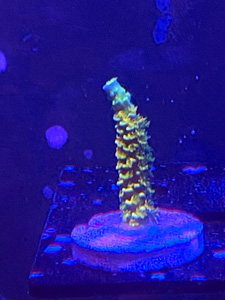Coral Fragging Overview
Keeping an aquarium is like underwater gardening. In keeping with this analogy, fragging a coral is like pruning a plant. In a successful reef tank, corals will grow, and grow, and grow. How big will a coral get? It could grow larger than your dining room table! The way to stop your tank from being dominated by just a couple corals is by cutting fragments off of your corals, an action better known as fragging a coral. You will want to regularly cut pieces off so that they don’t sting, overgrow, or shade out other corals. These pieces can then regrow into new coral colonies.
 Fragging Soft Corals
Fragging Soft Corals – Soft corals are some of the fastest growing corals and they need to be fragged the most often. Soft corals, like leather corals and xenia, can be fragged easily with a sharp blade. You want the blade to be both sterile, to avoid infection, and sharp, to make the wound as clean as possible.
Popular tools for this include sharp surgical scalpels, and stainless steel scissors that won’t rust in saltwater. Or, you can use a simple razor blade. The razor blade must be very sharp and can be discarded after use to ensure sanitation.
Corals can be cut inside or outside of the water. Once you have cut off a fragment, or frag, you’ll need to reattach the piece to something so it doesn’t blow away in the current of your tank. Some common things to attach frags to include rock rubble and, more commonly,
Frag Plugs. To attach the coral to the plug you can use
MarineAndReef.com Extra Thick Maxi Cure Glue. Coral glue can only be applied outside of the water, but it can harden underwater. Typically the glue is applied to the frag plug and then the coral is removed from the water and placed on top of the frag plug. The frag plug and coral can then be returned to the water and placed on a rack or a section of
Egg Crate. The
CPR & FijiCube Refugiums are an excellent place to put egg crate and frag racks because they will shield the newly cut frags from the aquarium’s water flow and stop the corals from blowing off the frag plugs if your glue job wasn’t perfect. Get the
Inland Seas 5" x 15" Fragcrate Fragging Package to get the egg crate, glue, and plugs in one package.
For soft corals, such as mushroom corals and zoanthids, it is best to remove the top layer of rock that the coral is growing on with a chisel or flat head screwdriver, and then glue the small piece of rock to the frag plug.
Fragging Hard Corals – Hard corals are more difficult to frag because they have hard skeletons. To cut through these skeletons you’ll need to use a

bone cutter, or saw (
see our Coral Fragging Video). Coral clippers are great for cutting through most corals, but for very thick corals a diamond-edged saw is needed. The easiest way to access a diamond saw is to purchase a diamond saw blade for a dermal or other rotary tool. When using clippers it is best to clip inside of the aquarium, but with the saw the whole coral must be removed before cutting. Once the cutting is finished you can attach the coral fragments just as you would with soft corals.
Bird’s nest corals, some species of acropora, and some other hard corals can be difficult to mount with glue alone. For these corals,
Two Little Fishies Aquastik Aquarium Epoxy Putty is a better choice. AquaStik is an epoxy putty that can be easily wrapped around the thin base of branching corals. While epoxy does take a while to harden, it can harden underwater (in about 6-12 hours), and it is thick enough to hold most corals in place before it hardens completely. This allows you to keep the coral underwater and adjust the position of the coral on the plug for a good amount of time before the epoxy hardens.
After fragging your coral it will have an open wound where you cut it. Usually, the coral will heal by itself, but sometimes this open cut can get infected. To avoid this use the proper tools so the cut is as clean as possible and use an iodine dip to sterilize the wound and encourage new coral growth.
Brightwell Aquatics Lugol's Solution is an excellent iodine dip. To use, add the manufacturerirecommended amount of drops to some of your aquarium water in a separate container, and then place the coral in the solution and swish it around for about 10 minutes. After the dip, you can return the coral to the aquarium. It is best to perform coral dips 1-2 days after fragging a coral as not to have too many stressful events back to back.
Once your coral fragments have recovered and started to grow again you can sell them, trade them with fellow aquarists, or transplant them to new areas in your tank. Propagating corals is an excellent way to find new enjoyment from the hobby and reduce the number of wild coral colonies taken from the ocean.




























 Fragging Soft Corals – Soft corals are some of the fastest growing corals and they need to be fragged the most often. Soft corals, like leather corals and xenia, can be fragged easily with a sharp blade. You want the blade to be both sterile, to avoid infection, and sharp, to make the wound as clean as possible.
Fragging Soft Corals – Soft corals are some of the fastest growing corals and they need to be fragged the most often. Soft corals, like leather corals and xenia, can be fragged easily with a sharp blade. You want the blade to be both sterile, to avoid infection, and sharp, to make the wound as clean as possible.
 bone cutter, or saw (see our
bone cutter, or saw (see our